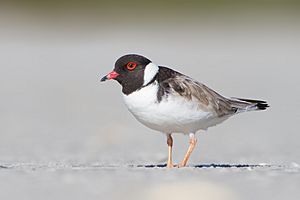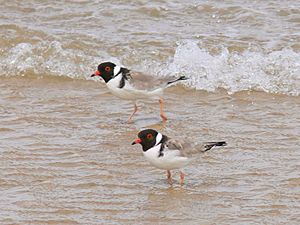Hooded dotterel facts for kids
Quick facts for kids Hooded dotterel |
|
|---|---|
 |
|
| A hooded dotterel at Prosser River Spit in Tasmania, Australia. | |
| Conservation status | |
| Scientific classification | |
| Genus: |
Thinornis
|
| Species: |
cucullatus
|
| Synonyms | |
|
Charadrius rubricollis Gmelin, 1789 |
|
The hooded dotterel or hooded plover (Thinornis cucullatus) is a special type of bird. It belongs to the Charadriidae family, which includes plovers and lapwings. This bird lives only in southern Australia and Tasmania.
You can find hooded dotterels on ocean beaches and in lagoons near the coast. There are two main groups, called subspecies, of these birds. They live in different areas, one in the east and one in the west. The eastern group needs more protection because its numbers are quite low in places like South Australia, Victoria, and New South Wales.
Contents
About the Hooded Dotterel
Birds are grouped by scientists into families and genera. A genus is like a smaller group within a family. The hooded dotterel used to be in the Charadrius group. But around the year 2000, scientists moved it to the Thinornis group. This group also includes the shore plover.
In 2000, it was thought there were about 7,000 adult hooded dotterels. People sometimes call this bird the hooded plover or "hoody."
Different Types of Hooded Dotterels
There are two main subspecies (types) of the hooded dotterel:
- T. c. cucullatus (Vieillot, 1818): This group lives in southern Australia, Queensland, New South Wales, Tasmania, and nearby islands. There are about 3,000 of these birds, and their numbers are going down.
- T. c. tregellasi (Mathews, 1912): This group lives in Western Australia. You can find them on coasts and near inland lakes, like around Cranbrook and Yalgorup National Park. There are about 4,000 of these birds, and their numbers seem to be staying steady.
What They Look Like
The hooded dotterel is a medium-sized plover. It is quite stocky and has pale feathers. It is about 19 to 23 centimeters (7.5 to 9 inches) long. Its wings can spread from 23 to 44 centimeters (9 to 17 inches) wide.
This bird has a black hood and throat. It also has a white collar around its neck. Its bill is red with a black tip. It has a red ring around its eye and orange legs. The feathers on its belly are white.
Male and female hooded dotterels look very similar. Young birds look like adults, but their heads and the back of their necks are sandy brown instead of black.
Life Cycle and Behaviour
Hooded dotterels usually lay 1 to 3 eggs. They lay their eggs from August to March. This time often includes the busiest tourist season in Australia. This means human activities can greatly affect their nests.
The eggs are a dull beige or cream color. They have many dark brown and lavender spots, especially at the wider end. The eggs are shaped like a pear and measure about 3.7 by 2.7 centimeters (1.5 by 1.1 inches). The eggs hatch in about 30 days.
The eastern population of hooded dotterels eats many different small creatures without backbones, called invertebrates. These include insects, clams (bivalves), and sandhoppers. Not much is known about what the western population eats.
Hooded dotterels are usually seen in pairs or small groups near the water. For breeding, they dig a shallow dip in the sand or gravel. They make their nest above the high-water mark. They line it with small stones, seaweed, and other bits of material.
Threats to Hooded Dotterels
The number of hooded dotterels in eastern Australia has gone down. This is because of disturbances from people, dogs, cats, and horses. Also, predators like silver gulls, ravens, and introduced foxes hunt them. Foxes are a big danger to the western subspecies too.
Where They Live and Their Home
The natural homes for hooded dotterels are freshwater lakes, freshwater marshes, salty lagoons near the coast, and sandy beaches. Many of them live on beaches that have seaweed and sand dunes.
Their population is small, and they live in a limited area. This makes them vulnerable to habitat loss. They do not migrate, meaning they stay in the same area all year. They live along the coasts of Western Australia, South Australia, New South Wales, Victoria, and Tasmania. Sometimes, they are seen in Queensland, but it's rare.
Conservation Efforts
| Subspecies | AUS | NSW | VIC | TAS | SA | WA |
|---|---|---|---|---|---|---|
| Thinornis cucullatus cucullatus | Vulnerable | Critically endangered | Vulnerable | Conservation Concern | Vulnerable | - |
| Thinornis cucullatus tregellasi | Not listed | - | - | - | - | Not Listed |
Many groups are working to protect the hooded dotterel. BirdLife International has named several places as important for helping these birds. These places are called Important Bird Areas.
Important Bird Areas
Here are some of the important places for hooded dotterel conservation:
|
|
|
See also
 In Spanish: Chorlito encapuchado para niños
In Spanish: Chorlito encapuchado para niños





